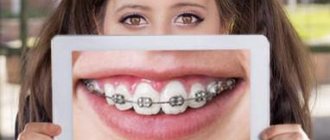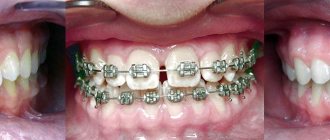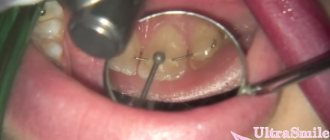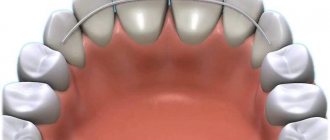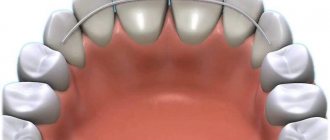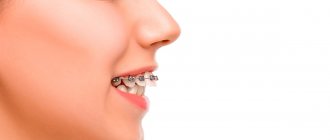Publication date: December 26, 2022.
Date the information on this page was updated: December 07, 2021.
Before installing braces, it is difficult to imagine the sensations in your mouth after installing an unusual structure made of ceramic or metal. Some people even put off orthodontic treatment due to fear of pain. In this article we will try to explain what sensations arise when installing, wearing and removing braces, why they occur and how to reduce discomfort.
Why does pain occur when wearing braces?
To begin with, let's figure out how the dental system works and how braces work. Teeth grow from the alveolar process, a bone formation in the jaw. The roots of the teeth are fixed in the bone tissue by a ligamentous apparatus - periodontium.
Due to the traction of the arc, braces move not only the part of the teeth that is visible to us - the crown, but also the roots of the teeth. Under the influence of braces, the ligaments, which contain many nerve endings, gradually stretch and the tooth moves along the bone tissue.
It is the processes of movement of the roots of teeth that cause sensations of varying degrees of intensity in people, depending on the individual pain threshold. Some people feel quite severe pain, some only have unpleasant feelings when biting food, others experience itching and mobility of teeth.
What does it feel like while wearing braces?
- Aching pain, especially aggravated when biting food and chewing.
- Chafing of cheeks, lips and tongue from clasps, orthodontic hooks and wires. During the first time after installation, the mucous membrane gets used to the structure in the mouth, the tongue and lips tend to take their usual position, but encounter braces. Sometimes it is impossible to close your lips or articulate clearly. Over time, the mouth and lips adapt to braces and the pain goes away. Getting used to with lingual braces takes longer than with classic braces, since they are located on the inside of the teeth and greatly interfere with the tongue.
- Feeling of tooth mobility and “soft” teeth. It seems that the tooth is loose or, when biting and pressing, “sinks” into the gum. In fact, the teeth are mobile, but not so much that they fall out or suddenly change position.
- Itching in the teeth and gums. Some patients' teeth do not hurt, but itch and itch. This, like aching pain, is the result of irritation of nerve endings during the gradual restructuring of periodontal and bone tissue. If you experience such sensations, you should never try to mechanically scratch your gums (with a toothpick, hard brush, etc.) - you can seriously injure yourself.
When does discomfort or pain occur during orthodontic treatment?
When wearing braces, your teeth do not constantly hurt: soon after installation, the oral cavity adapts to the structure, and the braces act on the ligaments gradually and gently. The sensations from braces are especially strong during the installation and activation stages, when the teeth are not yet accustomed to the pressure and new position.
Feeling when installing braces
The process of installing braces consists of three stages: preparing the teeth, gluing with a lock and installing the arch. The first 3 stages are absolutely painless - with healthy enamel (and this is a prerequisite for installing braces), applying the adhesive, drying and etching the tooth does not cause any discomfort. But when fixing the arch, a feeling of tightness and “heaviness” of the teeth appears. It is from this moment that braces begin to work - the arch, fixed in the grooves of braces on uneven teeth, strives to take its original “correct” position and pulls the teeth along with it.
In the first 1-3 weeks, unusual pressure is placed on the teeth, and the patient may experience quite severe pain. During this period, it is difficult to chew even soft foods, because with any pressure on the teeth, the pain worsens significantly, and a feeling of mobility appears.
During this period, in addition to pain in the area of the roots of the teeth and the alveolar process, the cheeks, lips and tongue may hurt due to unusual contact with braces.
Feelings when wearing braces
After adaptation to braces, severe pain goes away, and the design becomes familiar - most of the time, patients do not notice the presence of braces and live a normal life.
Discomfort returns with periodic activation of braces - on average once every 3 months. At appointments, the orthodontist can replace the archwire with a more rigid one, make bends in the archwire, re-glue the clasps, install a chain, or fix hooks for elastics.
Elastic traction for braces
After each small change, braces begin to work in a new way - pulling the teeth a little harder, or at a slightly different angle. The teeth begin to realign again and the patient may experience pain or discomfort. New hooks for elastics can injure the mucous membrane at first.
If the orthodontist has prescribed the wearing of rubber bands - elastics, then they can become a source of unusual sensations in the mouth: they pull and put pressure on individual teeth. Sometimes the sensation spreads to the entire jaw: it feels heavy and tense.
Feelings when removing braces
Even if after two years of wearing braces it seems that the braces have become one with the teeth and it will be painful to remove them, do not be afraid. In fact, removing braces is safe and painless due to the removal technology and special tools.
The bracket is grabbed with special pliers, which are securely fixed on the sides of the lock and do not slip off. The orthodontist squeezes the forceps, under pressure the bracket is slightly deformed, and its base easily peels off from the tooth. Next, the teeth are cleaned of the adhesive and polished.
Removing braces
The entire removal process takes up to 30 minutes and does not injure the teeth, gums or mucous membranes. Sometimes you can only feel a slight pressure when peeling off the locks.
Types of braces systems and their installation
Depending on the degree of complexity of correcting existing defects and the planned time for the patient to wear braces, the doctor suggests two main types of their design:
- Removable bracket system
It is recommended to remove it before eating and while brushing your teeth.
- Fixed system
The system is not removed for the entire duration of treatment. While wearing it, the doctor regularly makes certain adjustments.
None of the patients complained that their teeth hurt from braces when they were installed. Although such a procedure can last 1.5-2.0 hours. The painlessness of the operation is explained by the fact that the design of the braces during installation comes into direct contact with the tooth enamel, which has no nerve endings and simply does not feel pain.
The above installation times are averages. The duration of the operation depends on the following:
- doctor's qualifications and practical experience.
- individual characteristics of the patient’s teeth and jaw.
Pain when wearing braces that is not normal
Above we described discomfort with braces, which is normal. But some painful sensations indicate inflammatory or pathological processes.
The fact is that orthodontic treatment is a serious test for the body. The entire dental system is being rebuilt and requires special monitoring and care.
What sensations may indicate the presence of dental diseases:
- Aching and sharp pain in individual teeth
can be caused by caries or inflammation of the canals. - Pain in the area of contact between the gums and teeth
as a result of recession - loss of gums. Recession often accompanies orthodontic treatment, as the roots of the teeth move and put pressure on the periodontal tissue, which can cause gradual gum resorption. - Pain in the temporomandibular joint.
Some patients are predisposed to TMJ dysfunction - the joint can move into a new position during orthodontic treatment and cause discomfort and discomfort. You must report them to the orthodontist - the doctor will take the necessary measures. - Enamel sensitivity
. Braces make hygiene difficult and can weaken tooth enamel. If the enamel is excessively sensitive, you should definitely visit a therapist or hygienist. A specialist will clean and remineralize your teeth.
To prevent the development of inflammation, undergo professional hygiene and a preventive examination with a therapist at least once every six months. Report any strange or sharp sensations in your teeth, gums and joints to your orthodontist.
Medical Internet conferences
Relevance. The dental system has undergone significant transformations in the process of evolution. This is directly related to changes in the human diet. This is mainly reflected in the shortening of the length of the jaws, the reduction of the third large molar. All this leads to a lack of space for the eruption of permanent and sometimes baby teeth. As a result, various types of pathological bites and anomalies in the position of teeth arise. The prevalence of dental anomalies ranges from 11.4 to 71.7%, which depends on the methodological level of research, professional training of doctors, and representativeness errors [6]. In this regard, to solve these problems, the relevance of the issue of installing bracket systems, which have not only positive properties, but also negative ones, is growing. It is necessary to study the impact of braces, both local and general, in order to minimize the disadvantages and maximize their advantages using innovative technologies.
Purpose: to study the effect of braces on the dental system and the occurrence of changes in the body as a whole.
Tasks:
1) study the effect of braces on the spine, organs of vision, explain the appearance of headaches;
2) identify what changes occur in tooth tissue, periodontal tissue, and bone tissue.
Materials and methods. An analysis of scientific articles, journals, and dissertations on this topic was carried out.
Results and discussions. Correction of pathological types of occlusion, anomalies in the position of teeth in the upper and lower jaws is an important problem for the dentist. However, when installing fixed orthodontic structures, patients experience general complaints: headache, impaired posture, vision, and possible manifestation of astheno-vegetative syndrome. All these symptoms arise due to transformations in cranial-sacral biomechanics, which are caused by fixed orthodontic appliances [3]. There is a close relationship between all organs of the maxillofacial region, which manifests itself in morpho-functional unity [6]. This determines the fact that when one link of this system is influenced, changes occur in the entire dentofacial complex. Thus, when installing braces, a kind of cascade of reactions is triggered: teeth-dentition-jaws-bones of the skull-muscles of the neck and spine [5].
Tension of the muscles of the neck and spine leads to such general disorders as changes in posture and headaches. A more detailed pathogenesis of headaches is explained by the fact that when the neck muscles are overstrained, tension in the scalp muscles occurs, which leads to attacks of so-called tension headaches.
The connection between the dentoalveolar system, the muscles of the shoulder girdle and the spine determines changes in the stabilometric indicators of the functional balance of the human body and, as a consequence, a change in the center of gravity entails a violation of posture, which occurs in 71.4% of patients undergoing orthodontic treatment [3].
When using braces, bone tissue is rebuilt in the area of the sutures of the skull. In this case, overstretching of the lateral group of neck muscles is noted. This leads to compression of the external and internal carotid arteries. In this case, there is a deterioration not only in blood flow, but also in its outflow. The brain is under ischemic conditions for a long time. Oxygen starvation is the cause of astheno-vegetative syndrome, which is manifested by rapid fatigue and memory impairment. These complaints occur in 93.7% of patients [3].
In addition, vasospasm and cerebral ischemia significantly impair the trophism of the optic nerves. This leads to gradual deterioration of vision in 31.8% of patients [3].
After the installation of braces, various negative processes occur in the dental system. These include changes in the hard tissues of the tooth, periodontal tissues, and bone tissue of the alveolar process.
Elements of the bracket system make it difficult to carry out high-quality oral hygiene, the mineralizing function of saliva and microhemocirculation in periodontal tissues change [4], local and humoral immunity is disrupted [1], and the quantitative composition of the microbial flora increases. All this contributes to the accumulation of soft dental deposits and the formation of dental plaque, which can subsequently give rise to the development of a carious process.
Fixing and changing various elements of the bracket system, etching, grinding and polishing enamel can cause dental hypersensitivity (DSH) in patients. A long-standing problem of HCH can leave its mark on the patient's behavior (for example, the requirement to perform anesthesia even before the simplest non-invasive procedures) [3].
After installing braces, oral diseases such as gingivitis and periodontitis may occur. The development of the inflammatory process in periodontal tissues is usually associated with deterioration of oral hygiene during orthodontic treatment, incorrect choice of orthodontic design, and the initial state of periodontal tissues and hard dental tissues [2].
When the braces system affects the dentition, deformation of the jaws occurs, a long, complex process of restructuring the bone trabeculae is observed, bone tissue resorption in the place where the tooth should not be and its formation in the place where the tooth needs to be “moved”. The result of an incorrect choice of orthodontic design or errors in the placement of the bracket system can result in the occurrence of a pathological bite and incorrect jaw relationship.
Braces also affect the condition of the temporomandibular joint (TMJ). After installing braces, an unusual feeling of discomfort appears, excessive pressure on the dentition, hypertonicity of the masticatory muscles, which can contribute to the occurrence of pain and crunching in the TMJ.
Also relevant is the question of the patient’s quality of life after removing braces. Positive results include obtaining a functional, aesthetic and morphological optimum. A negative result is the occurrence of relapses, that is, a gradual return of the bite to its original state. This is due to the fact that after the braces are removed, the new position of the teeth is based not on bone, but on cartilage tissue. Only after this tissue has been converted into bone can the treatment be completed. The quality of the results of active treatment, in turn, is associated with the treatment methods used and the algorithm for their application. As a result, patients have to continue treatment using other removable and non-removable structures. If you do not consolidate the result, then we can assume that the long process of wearing braces is completely useless.
Conclusions:
1) braces have both positive and negative effects on the dental system and the body as a whole;
2) general changes are observed in the spine, namely, this is a process of changing posture, changes occur in the muscles of the neck, which leads to decreased vision, tension headaches, fatigue and memory impairment;
3) local effects include changes in tooth tissue, periodontal tissue, as well as in bone tissue;
4) based on this analysis, we can say that with the correct approach of the patient to treatment with fixed orthodontic appliances, as well as after their removal, subject to many rules and instructions from the doctor, the negative effects of using braces can be avoided and only positive results can be obtained.
How to relieve pain when wearing braces?
Each patient experiences individual sensations from braces, but even severe pain can be reduced if you follow the recommendations of doctors.
At the stage of choosing braces:
- Choose self-ligating braces - they put less aggressive pressure on the teeth than ligature ones. In self-ligating braces, the arch slides freely in the groove, and the force is distributed evenly.
- If you need faster and easier adaptation to braces, choose external or vestibular braces - they do not injure the tongue and do not spoil diction.
After installation and activation:
- Use orthodontic wax to smooth out protruding elements that rub the mucous membrane.
- Doesn't eat solid food. In the first 3 weeks after installing braces, it is recommended to eat only soft or pureed foods: purees, soups, etc.
- Rinse your mouth with anti-inflammatory agents (saline solution, chamomile decoction) so that inflammation does not occur at the site of the wounds from braces.
- Use healing gels to treat mucous membranes.
- Eat ice cream or drink cool water - cold foods reduce sensitivity.
Sensitivity while wearing braces varies from person to person. It is possible that orthodontic treatment will be completely free of pain and discomfort. But even painful sensations are not constant and are easily neutralized. And the excellent result after braces compensates for all the inconveniences.
Why do braces chafe?
The orthodontic system has a certain volume. It consists of streamlined clasps that can come off, a power arc that protrudes significantly forward in relation to the front surface of the teeth. Ligature systems additionally have ligatures, thin wires that secure the arch to the braces.
Normally, the amount of space between the teeth and the soft tissues of the face (the inner surface of the cheeks and lips) is very small. It is supported by a certain tone of the facial and chewing muscles. In order for the muscle tone to change taking into account the installed structure, time must pass. Usually this is 2 weeks or more.
Immediately after installation, the system is perceived as a foreign object in the mouth, which interferes with chewing, speaking, “rests” with all protruding parts on the mucous membrane, and rubs against the tissue during muscle contraction. To a certain extent, this discomfort is acceptable and is one of the disadvantages of correcting the position of teeth with braces.
For example, slight bleeding of the mucous membranes at the points of contact of structural elements with tissues is not a reason to consult a doctor if this is a one-time bleeding and the mucous membrane heals within a short time. The soft tissues of the oral cavity are well supplied with blood. This is facilitated by a dense capillary network, which produces profuse bleeding in response to any minor damage.
It’s another matter if erosions and ulcers form, which can become an “entry gate” for infection. The enzyme lysozyme contained in saliva usually suppresses the proliferation of microorganisms. However, its effect may be insufficient in the case of long-existing defects.
How to reduce discomfort from wearing braces?
There are many techniques that can reduce pain from the pressure of the orthodontic structure on the teeth. It is possible that your doctor will tell you about them at your appointment, but if not, you can use our list of recommendations.
Food selection:
- From the first day of wearing the system, it is recommended to switch to food with a soft consistency, then you can gradually expand your diet, focusing on the sensations in your mouth;
- cold food causes less discomfort than warm or hot food;
- sour and spicy foods cause increased pain;
- Solid foods such as seeds and whole nuts are prohibited during the entire treatment period.
Changing habitual behavior:
- in the first 10-14 days it is recommended to make as little movements as possible with facial muscles: smile less, talk less;
- During the entire treatment, it is better not to sleep with your face buried in a pillow, as this increases the pressure of the system on the teeth and reduces the life of the structure.
Hygienic care:
- To brush your teeth, it is advisable to use a toothbrush with soft bristles and a small head;
- the retail chain has special toothpastes for braces;
- After each meal, you must rinse your mouth with a special mouthwash.
Medications help reduce discomfort:
- Non-steroidal anti-inflammatory drugs. Painkillers cannot be taken all the time, but in the first few days you cannot do without them. There are no special recommendations here. Any medications that the patient took for headaches before installing braces will be effective.
- Local anesthetics. A much safer group of drugs compared to painkillers in tablets, but practically unknown to a wide range of users. Examples include Colgate Orabase or Orajel. They are used topically, applied to the gums after rinsing the mouth.
The most difficult times when wearing braces are the first two weeks, the period of adaptation to the pressure of the orthodontic structure on the teeth. It should be easier further. If time passes and the level of discomfort does not decrease, you should notify your doctor. Perhaps something is going wrong and willful efforts to ignore the problem will only be harmful.
How long to wear braces?
What determines the duration of wearing braces
Duration of treatment with braces in children
How long does it take to install braces?
How long does it take to get used to braces?
How long does the retention period last?
Correcting the bite and straightening the teeth is a rather lengthy process, which for many is a stumbling block to orthodontic treatment. How long you need to wear braces is a question to which even orthodontists do not know the exact answer, since each case is individual. Let's look at what factors influence the timing of wearing braces.
